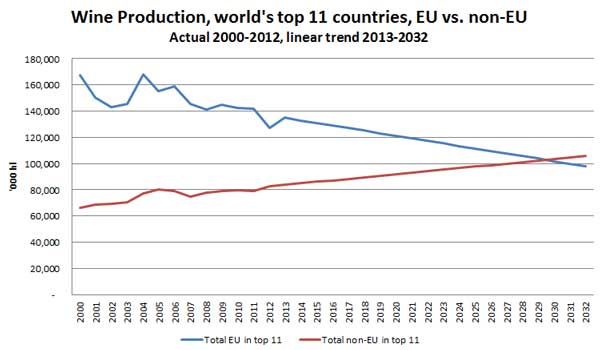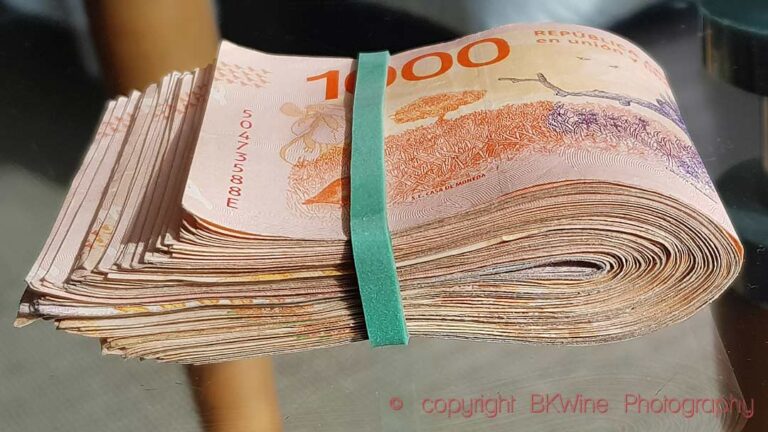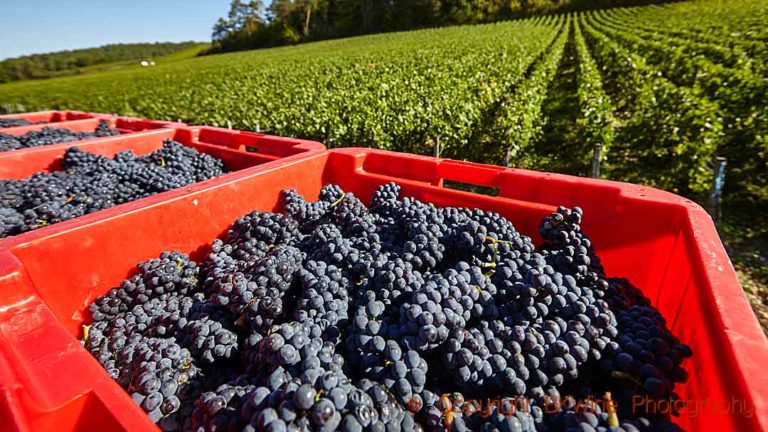The 2014 statistics on global wine production, wine consumption, vineyard surface area, world grape production, and world trade in wine
France will be the world’s biggest wine producer in 2014. World vineyard surface is decreasing but grape production is going up. Europe’s production is in decline. World wine consumption is shifting from “old” countries to “new” countries. China is the world’s biggest producer of grapes (but not of wine). These were some of the conclusions of the world wine statistics presented at the recent OIV congress.
 OIV, the International Organisation of Vine and Wine (Organisation Internationale de la Vigne et du Vin), is a sort of United Nations for wine. It is mainly a technical cooperation organisation for wine producing countries but they are also a source for very interesting statistics. And, as I am sure you agree, statistics are very interesting! The latest statistics were released at the 37th OIV world congress.
OIV, the International Organisation of Vine and Wine (Organisation Internationale de la Vigne et du Vin), is a sort of United Nations for wine. It is mainly a technical cooperation organisation for wine producing countries but they are also a source for very interesting statistics. And, as I am sure you agree, statistics are very interesting! The latest statistics were released at the 37th OIV world congress.
World wine production
World wine production decreased with 6% in 2014 to reach 271 million hectolitres (Mhl). This decrease is in parts due to bad weather in some countries. This number is almost exactly equal to the average global wine production over the period 2000-2012.
As has for many years been the long term trend, wine production is decreasing overall in Europe. As I have noted previously (The world’s wine production 2000-2012) if this trend continues Europe will no longer be the world’s premier source of wine by 2030.
Some facts for 2014 for wine production:
- France will be the biggest wine producer in 2014, making 46.6 million hl
- Italy is pushed down to second place with 44.4 Mhl. Every year France and Italy jockeys for first place. Sometimes it is the one, other times the other.
- Spain is in third place. After a very big harvest 2013 it is back down to 37 Mhl
- New World countries are increasing their wine production: USA makes 22.5 Mhl, Argentina 15.2 Mhl (+1%), South Africa 11 Mhl (+4%), New Zeeland 3.2 Mhl (+29%)
Since Europe’s production is shrinking and world production is almost constant, someone else must be growing. The growth is seen in most other regions outside Europe. (You can find more details in the article referenced above.)

Global wine consumption
Global wine consumption is estimated to 234 million hectolitres in 2014. This is essentially a stable number for well over a decade. (Read more number on wine consumption in my previous article: The world’s wine consumption 2000-2012)
The OIV concludes that these numbers confirm that wine consumption is increasingly driven by “new” wine countries, i.e. other than the traditional wine producing countries. Consumption is decreasing in for example France, Italy and Spain. Instead it is growing in countries such as China, Russia, Australia, and of course in the USA. The USA is now expected to be the biggest wine consuming country (albeit not the biggest consumption per capita).
Today 39% of the world wine consumption is outside Europe. In 2000 it was only 31%. However, still more than 60% of all wine is consumed within Europe.
Global wine trade
Less wine being drunk in wine producing countries and more being consumed in countries that do not have a significant wine production means more trade in wine.
Today 40% of all wine is consumed in other countries than where it was produced (i.e. imports represent 40% of wine consumption). In 2000 the number was much lower, only 25%.
This being said, the numbers from the OIV show that the volume of world trade in wine decreased in 2013 with 2.2% to 98 Mhl. However, the value of this trade increased with 1.5% to 25.7 billion euro.
World vineyard surface area
Today there is 7,519,000 hectares of vineyards world-wide according to the OIV estimates. The world’s vineyards are shrinking from a peak of almost 8 million ha in 2003. (See more on world vineyard surface in my previous article: The world’s grape growing (vineyard) surface area 2000-2012).
This decrease is to a large extent a result of Europe’s (the EU’s) policy of uprooting vineyards, a farming policy that has evidently been quite successful.
Some other countries are instead increasing the vineyard area, notably China and countries in South America.
Global grape production
Global grape production is a quite different issue than global wine production. Much of the grapes produced in the world end up as fruit juice or as dried raisins.
Global grape production is today 751 million quintals (Mq). A quintal is a measure often used for grape production that equals 100 kg, so the world grape production is around 75 million tonnes.
The world’s biggest grape producer is China!
In China some 115 Mq is produced, thus representing 15% of global grape production. The leading position of China as a grape producer is relatively new. Still in 2005 it was only in 5th place after Italy, the USA, France and Spain.
In second place you have Italy with 70 Mq, and then the USA with 75 Mq.
Read more on world grape production in my previous article here: The world’s grape production 2000-2012.











One Response